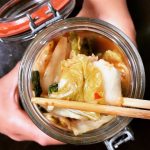Simple Kimchi
Ingredients
- 1 two-pound Napa cabbage cut into 2-inch pieces
- 1 daikon radish peeled and cut into 2-inch matchsticks about 1/8-inch thick
- 4 green onions cut into 1-inch pieces
- 1/4 cup salt
- Water to cover vegetables
- 6 cloves garlic minced
- 1 inch piece of ginger peeled and minced or grated
- 1/4 cup gochugaru or 2 teaspoons crushed red pepper
- 1 teaspoon dried kelp granules optional but recommended
Instructions
- In a large bowl, toss the vegetables. Sprinkle on the salt and combine everything with your hands. Pour water over the vegetables until almost covered. Place a plate over the vegetables and place a weight on the plate (I use a jug filled with water). If the vegetables and not completely submerged in water, add more. Cover the bowl with a towel and let the vegetables sit for a couple of hours or overnight to allow them to soften. (I started this batch at night, was tired and went to bed and continued the recipe in the morning.)
- In a separate bowl, combine the garlic, ginger, gochugaru and kelp powder if using.
- Drain the salt water brine and reserve it. Taste the vegetables. If they taste too salty, rinse them. If they don't taste salty enough, sprinkle on more salt, mix and taste. Add more salt if necessary.
- Sprinkle the spice mixture onto the vegetables and mix together until combined.
- Pack the vegetables into a clean quart-size jar. I use my bare hands for this but, depending on the spices and how much you put in, you may want to use a large wooden spoon, pestle or, if you have one, a wooden pounder.
- To ensure the vegetables remain submerged in liquid—they will not ferment properly if exposed to the air—weigh them down. I do this by placing a small jar within the quart jar and closing the lid. The small jar will push down the vegetables in the larger jar, submerging them in liquid. If you need to add more liquid, pour some of the reserved brine over the vegetables.
- Place the jar on a plate on the counter to catch liquid that will soon begin to bubble and escape from the jar. Taste daily. Depending on your kitchen, your kimchi will be ready in about three days. Kimchi tastes best when young, unlike sauerkraut, which can ferment for many weeks or even months.
- Refrigerate and eat your kimchi within a couple of weeks.
Notes
1. Chlorine can kill the microbes necessary to ferment food. If your water contains high amounts of it, pour some into an open vessel the night before you make this. The chlorine will dissipate.
2. I buy organic ingredients but fermentation will work with non-organic ingredients with the exception of ginger-based recipes. Non-organic ginger may be irradiated, which kills the naturally occurring microbes necessary for the fermentation. For pickled ginger or ginger beer, choose organic ginger. The small amount of ginger in this recipe may be organic or non-organic.
3. Kelp powder adds some of the fishy flavor that kimchi calls for. Some recipes also call for a bit of sugar. I've had kimchi with shredded apple and that was delicious.
